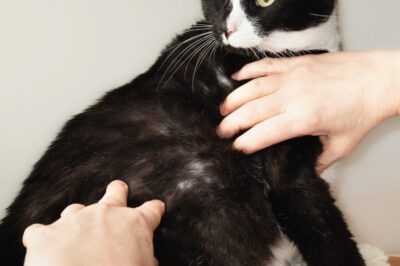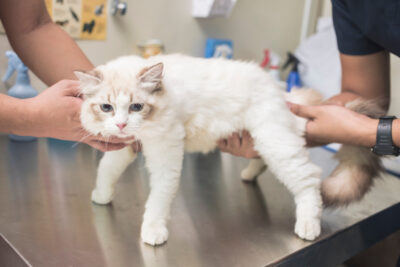How to Tell if a Cat Has a Fever

Cats have a reputation for being stoic in the face of injury or illness. Unfortunately, that can make it hard to recognize when your cat’s not feeling well. Fever is usually a helpful indication of illness in cats. But if your cat won’t let you take their temperature, figuring out how to tell if a cat has a fever can be tricky.
If you’re worried about whether or not your feline is feverish, you’ve come to the right place! Here’s a helpful guide that covers how to recognize signs of fevers in cats, how to take a cat’s temperature, and when you should visit the veterinarian.
What’s a Normal Cat Temperature?
If you look up the normal cat temperature, you’ll find a wide range of results…all of which claim to be the standard.
For example, a 2015 study from the Journal of Feline Medicine & Surgery states that the normal range for adult cat body temperature should be between 98.1°F to 102.1°F (36.7 °C to 38.9°C). (1) However, it’s common for veterinarians to see ranges from 100°F to 102.5°F (37.8°C to 39.2°C) in clinic. And many vets consider this a normal temp for cats.
There are other factors that may have some bearing on what we consider a normal cat temp, too. Some cat breeds run at a slightly warmer or cooler normal body temperature than others. However, what is considered an average cat temperature for each breed isn’t well-established. Kittens usually have a slightly higher baseline temperature than adult cats.
If your cat’s body temperature is abnormally elevated, it could be due to either hyperthermia or fever.
- Hyperthermia occurs when a cat’s temperature rises due to heat exposure or excessive physical activity (like having a seizure).
- Fevers, on the other hand, are caused by infections, injuries, autoimmune diseases, and cancers. If your cat develops a fever, you’ll want to contact your veterinarian to determine and treat the cause.
How to Tell if Your Cat Has a Fever: 6 Signs

Obviously, the best way to know your cat has a fever is to take their temperature. However, getting a cat to sit still and consent to a temperature check isn’t always in the cards. Instead, you may want to keep an eye out for other signs that your cat could have a fever, which include:
- Lethargy: A cat with a fever doesn’t feel well, so they’re likely to have a reduced activity level and may sleep more.
- Reduced appetite: The cat may show less interest in both food and water while they’re not feeling well.
- Shivering: Similar to how people often get chills and shiver when they have a fever, a cat with a fever may shiver.
- Poor grooming habits: Because the cat isn’t feeling well, they are often less fastidious about their grooming habits. You may notice clumped fur or an unkempt appearance when your cat is sick.
- Visible wounds, injuries, or swellings: Injuries can cause a fever, both due to inflammation and infection. Cats with abscesses or tumors can also develop fevers.
- Warm to the touch: While you cannot rely on this alone, a cat who is warm to the touch and has other signs of illness may have a fever. If you notice that your cat’s ears are hot or their face is hot to the touch, that’s a warning sign worth heeding. But it’s important to note that other factors — including your own body temperature, the weather, and your cat’s activity level — can all affect your perception of how warm your cat is.
Cats with other signs of illness, such as coughing or diarrhea, may also develop fevers related to whatever is causing their underlying infection.
Though it’s helpful to keep an eye out for cat fever symptoms, be aware that many things other than a fever could cause them. If you’re still unsure, the best way to tell if your cat has a fever is to take their temperature.
How to Take a Cat’s Temperature

If you’re wondering how to check a cat’s temperature at home, there are three main methods veterinarians recommend. You can use a digital thermometer designed for humans to measure your cat’s temperature. But, it’s a good idea to label your cat thermometer and store it separately from your family’s thermometers to avoid cross-contamination.
Here are three vet-recommended methods for measuring your cat’s temperature with a thermometer.
Axillary (armpit) temperature
While this method is generally considered the least accurate of the three, it’s also the least disruptive. So it’s a good choice if you have a cat who’s less than thrilled about having their temperature taken.
To use this method: Place the tip of a digital thermometer in your cat’s armpit, as far forward and upward as possible. Keep your cat’s leg down, trapping the thermometer against their body, until it shows the final result.
Rectal temperature
Veterinarians generally prefer this method for measuring a cat’s body temperature quickly and accurately. Cats, on the other hand, tend to be less tolerant of it. So you’ll definitely want to have a helper on hand.
To use this method: It’s best to have a digital rectal thermometer; these have a shorter, blunter tip than standard digital thermometers. Turn the thermometer on and apply lubricant to the tip. Then, lift the cat’s tail and gently insert the thermometer about half an inch into the anus. Make sure to wash the thermometer and your hands after it reads the temperature.
Ear temperature
Pet parents can also use a digital cat ear thermometer to take their cat’s temperature. This method appeals to many pet parents because it’s less invasive than taking a rectal temperature. However, it can be difficult to get the thermometer aimed at the correct location (inner ear canal) for an accurate reading. If there’s wax, debris, or discharge in your pet’s ear canal, that could also affect the reading (which is why vets don’t recommend it in cases of ear infection).
To use this method: Hold the ear thermometer horizontally and insert it gently into your cat’s ear canal until it shows the final result.
No matter which method you choose, it’s easier to take a cat’s temperature with at least one other person to help you. Your helper can hold your cat in position and soothe them.
Some cats may tolerate a rectal temperature better if you wrap them in a towel with their backside out. If your cat is attempting to bite, scratch, or is otherwise noncompliant, it’s best to contact your veterinarian. Together, you can review your cat’s symptoms and determine if a visit is in order.
When to Visit a Veterinarian

If your cat’s temperature is above 102.1°F and they’re acting abnormally, you should call your veterinarian.
If the temperature is above 103.5°F, consider seeking emergency attention immediately. You should also seek emergency attention if your cat is:
- Having seizures or acting disoriented
- Having difficulty breathing
- Unable to urinate and/or defecate
- Experiencing severe diarrhea or vomiting
- Completely disinterested in food
- Collapsing
- Severely injured (such as being hit by a car)
When you bring your cat in for evaluation, your veterinarian will try to determine what is causing your cat’s fever. This will involve a physical examination and additional diagnostics. These could include blood work, urine testing, X-rays, abdominal ultrasound, and more. Based on the findings, your veterinarian will recommend treatment.
Vets commonly prescribe nonsteroidal anti-inflammatory drugs (NSAIDs) like meloxicam to reduce fever in cats. Your cat may also receive fluids either under the skin (subcutaneously) or into their vein (intravenously). Rest assured, depending on the cause of your cat’s fever, your vet will tailor a specific treatment plan that fits your pet’s diagnosis and health needs.
A cat with a fever can be experiencing significant illness, even if they seem to be acting normal. The sooner you can get your feverish cat treatment, the better off they will be. That’s why it’s so important to familiarize yourself with the signs of illness and fever in cats. Recognizing warning signs could help head off more serious health issues.
If you can do it safely and accurately, taking your cat’s temperature is still the best way to find out if they have a fever. However, it should not be used as the sole indicator of disease. Pet parents should consider their cat’s overall clinical signs and behavior when deciding whether to contact their veterinarian.
Reference
Levy, Julie & Nutt, Kelly & Tucker, Sylvia. (2015). Reference interval for rectal temperature in healthy confined adult cats. Journal of Feline Medicine and Surgery. 17. 950-952. DOI:10.1177/1098612X15582081









